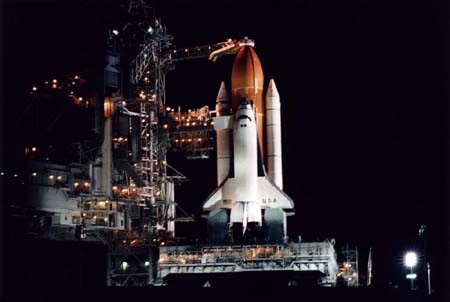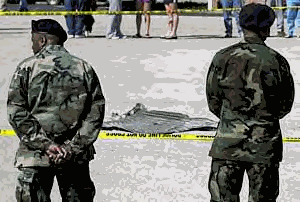 LUNAR’clips
2003
Volume 10, Number 1
LUNAR’clips
2003
Volume 10, Number 1
 LUNAR’clips
2003
Volume 10, Number 1
LUNAR’clips
2003
Volume 10, Number 1
Livermore Unit of the National Association of Rocketry January/February 2003
Copyright © 2003 by LUNAR, All rights reserved.

NASA Photo
Columbia (OV-102), was the first of NASA's orbiter fleet, and was delivered to Kennedy Space Center in March 1979. At that time I was living in Ireland and I recall watching the live telecast as Columbia initiated the Space Shuttle flight program, lifting off Pad A in the Launch Complex 39 area at KSC on April 12, 1981.
A few years ago I sat outside Kennedy Space Center, watching Columbia sit on the pad, as weather cancelled three scheduled launches. It lifted off into orbit a week after I got back from Florida.
During its lifetime, Columbia had undergone about 50 modifications, including the addition of carbon brakes, improved nose wheel steering and an enhancement of its thermal protection system. It was last refurbished in 1999.

Photo by Matt Stroshane/Getty Images
When it lifted into orbit on January 16, it was the 113th flight in the shuttle program's 22 year history, and the 28th flight for Columbia. The 16 day mission went smoothly and successfully.
On the morning of Saturday, February 1, the crew were awakened to the sound of Scotland the Brave being played by the 51st Highland Brigade. The day before, Mission Control had woken them up to the sound of Shalom Lach Eretz Nehederet, for Israeli astronaut Ilan Ramon. Thursday morning it had been John Lennon's Imagine. Scotland the Brave was for mission specialist Laurel Clark, Scottish by extraction.
"Good morning," Mission Control called up to the ship.
"Good morning, Houston," Clark answered. "We're getting ready for our big day up here ... I'm really excited to come back home. Hearing that song reminds me of all the different places down on Earth and all the friends and family that I have all over the world. "
She had reason to be excited, particularly since that business of coming home should have been relatively routine-at least by the high-wire standards of space travel. After shimmying out of their sleep restraints, the crew would stow gear and belt themselves into their seats-a process that would take a good six hours. With Columbia turned rump forward, the commander would then fire the main maneuvering engines, slowing the spacecraft and easing it toward the upper wisps of the atmosphere. Once he turned the ship around, he would surf the currents of the steadily thickening air, fishtailing this way and that until, just an hour or so after the deorbit engines were lit, Columbia's tires would make their smoking contact with the Cape Canaveral runway and the shuttle would come to a rolling stop.
That's the way it ought to have happened, at least, but only 15 minutes from its planned touchdown, more than 200,000 ft. (61,000 m) over Texas, the 22-year-old ship suddenly and fatally deconstructed itself, taking the lives of its seven crew members with it.
Columbia was traveling at more than 16,400 miles an hour as it approached the California coast in a high-speed descent shortly before 9 a.m. Eastern time.
There was no communications from the astronauts at the time. Typically for a return from space, the spacecraft commander, Rick Husband, and pilot, William McCool, would sit in the control seat at the front windshield, surrounded by elaborate controls including computer screens.
Just behind, at McCool's right shoulder, would be Laurel Blair Salton Clark, a physician. And behind both the pilot and commander was astronaut Kalpana Chawla. In a tight compartment below the cockpit were the other three astronauts - Michael P. Anderson, David M. Brown, and Ilan Ramon, the first Israeli astronaut.
Public affairs announcer James Hartsfield, speaking to the outside world from a microphone inside Mission Control, calmly ticked through the landing routine, calling off speed and altitude and distance to the landing runway. He told how the spacecraft, flying on autopilot, started the first of a series of banked maneuvers, designed to slow the craft as it entered the increasingly thick atmosphere.
At 8:53 a.m., engineers in Mission Control noticed there was a sudden loss of temperature readings in the hydraulic system in the left wing. Somehow, the temperature sensors were no long sending data.
Three minutes later, signals dropped from the temperature sensors in the left main landing gear.
Mission Control sent a notice to a cockpit electronic screen about the temperature readings.
Milt Heflin, chief flight director, said the crew acknowledged the signal, but it was thought ``there was no problem at that time.'' Such temperature reading losses have been seen before.
Hartsfield continued with routine landing reports, noting that the speeding craft was streaking across the New Mexico-Texas border at an altitude of 40 miles and a speed of 13,200 mph. Columbia, he said, was only 1,400 miles and less than 20 minutes from landing.
There was a muffled blurt on the radio from the crew.
Capsule communicator Charlie Hobaugh broke a long silence by calling to the crew.
``Columbia, Houston,'' he said, ``we see your tire pressure message and we did not copy your last.''
``Roger,'' said Husband. ``Uh, buh...''
The communication was cut abruptly, the final word never finished. It was followed by static.
At about the same time, all data signals abruptly stopped. Columbia's computers were no longer talking to Mission Control.

AP Photo/Tyler Morning Telegraph, Dr. Scott Lieberman
Columbia was then moving at more than 18 times the speed of sound and was some 207,000 feet - about 39 miles - above Texas.
Television images showed Columbia appeared to explode and break up above Texas, leaving several white trails across the blue skies instead of the single plume on a normal flight.

National Guardsmen stand watch over a piece of debris from the space shuttle
Columbia in Nacogdoches, Tx
Outside Mission Control, in the hot path the flaming Columbia cut through the sky, no one needed to see computer data to know the day had taken a bad turn. In Nacogdoches, Texas, 17-year-old Heath Drewery was in bed when he was jolted by what sounded like an explosion outside his house. "I heard this big rumble and thought a train had derailed," he says. He and his brother piled into their truck and drove into town, where the street was littered with debris. "There were pieces all over the place. It looked like it was charcoal." In San Augustine, things got more grisly still, when body parts fell from the sky.

People gather at a farm in Nacogdoches, Tx., to view a piece of debris from
the space shuttle Columbia
As NASA starts trying to pinpoint the cause of all this horror, investigators will have a lot of places to turn. The mission began with at least one anomaly when, at the moment of launch, a piece of foam broke from the insulation on the giant external fuel tank and struck the left wing of the ship. "We spent a goodly amount of time reviewing the film (of the launch) and analyzing what that might do," says shuttle program manager Ron Dittemore. "From our experience it was determined that the event did not represent a safety concern."

But that was before the hinky data started coming down from that same left side of the ship in the final seconds of the flight. Now the film that already got a once-over is going to be looked at a lot more closely. "We can't discount that those (events) may be connected," Dittemore admits, then hastens to add, "but a lot of things look like they're going to be the smoking gun in this business and turn out not to be."
If the falling foam did damage the ship, the most disturbing possibility is that it chipped or broke one or more of Columbia's heat-absorbing tiles. The spacecraft is protected from the hellish heat of re-entry by thermal blankets and about 24,000 black and white ceramic tiles. The jigsaw-puzzle pieces have given the space agency fits since the very first flight of the very first shuttle-Columbia in April 1981. Handfuls of them often flaked away during lift-off, leaving NASA with nothing to do but wait out the flight and hope that the skin had not been denuded in a critically hot spot. In a worst-case scenario, just a few missing tiles in even a relatively low-temperature area could lead to a fatal chain reaction, with possibly hundreds of them peeling away. "Losing a single tile can do you in," says Stanford University's Elisabeth Pate-Cornell, an engineer and risk-management specialist who once led a NASA study about all the ways shuttle tiles could fail. "Once you have lost the first tile, the adjacent ones become much more vulnerable." Since nothing this catastrophic ever happened in any of the prior shuttle flights, NASA grew increasingly-and justifiably-confident that the lightweight and durable shielding was the best of an admittedly imperfect set of options. Now there is reason to doubt. "Obviously, the loss of tiles has to be looked at and put to bed," says George Gleghorn, a former chief engineer for TRW's space group and, for six years, a member of a NASA safety-advisory panel. Others are asking why, if a piece of foam was known to have hit the ship, an astronaut wasn't sent outside during the course of the 16-day mission to determine whether any damage had been done.
Dittemore explains that this crew was not trained for that kind of extensive space walk, and even if they were and they found some damage, they could have done nothing about it anyway. "We had no capability to go over the side or under the spacecraft and look for an area of distress and repair a tile," he says.
TIME science correspondent Jeffrey Kluger says "Following the precedent of the Challenger disaster in 1986, it's unlikely that NASA will undertake any further shuttle missions or any other manned space flights for the next two years. One immediate problem, though, is the International Space Station, which currently has a crew of three on board. They might consider one further flight to bring that crew home - the other option would be for them to return aboard a Russian Soyuz craft, which isn't the most comfortable or the safest ride. Beyond that, however, the space station is likely to be left unoccupied for a long time. NASA won't want to use the shuttle again until it can establish the cause of today's accident, and fix it. Now that we've lost two shuttles out of a fleet of five, it's even conceivable that the shuttle won't fly again. The shuttle was built as a space truck, and then the International Space Station was built to give it something to do. Both programs are likely to suffer as a result of this disaster."
Return to IndexAll content is the responsibility of LUNAR.
If you have comments or suggestions regarding these web pages,
please contact the 
Copyright © 1992 - 2025 LUNAR